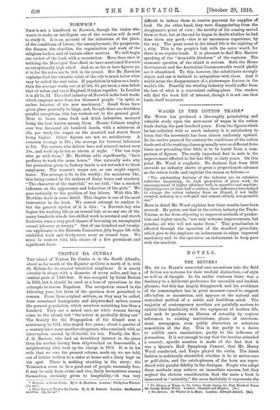NORWICH.*
THIS is not a handbook to Norwich, though the visitor who wants to make an intelligent use of the occasion will do well to study it. It is an account of the industries of the place, of the conditions of labour, the unemployment, the pauperism, the finance, the charities, the organisation and worlc. of the religious bodies, and of various other matters. We will begin our review of the book with a recantation. More than once in noticing the Municipal Year-Book we have mentioned Norwich as exceptionally high rated. And so, as far as bare figures go, it is, for the rates are 9s. 10d. in the pound. But Mr. Hawkins -explains that the rateable value of the city is much below what may be called the real value. If population be taken as a basis, then the average works out at 10s. 9d. per head, a sum below that of urban and rural England if taken together. In London it is £&5s. 3d. The chief industry of Norwich is the boot trade, which employs more than ten thousand people, "in spite, or rather because, of the new machinery." Small firms have given place generally to large, and, though there are doubtless painful exceptions, this has worked out to the general good. Next to boots come food and drink industries, mustard being the best known among them. Messrs. Colman employ over two thousand sit hundred hands, with a minimum of 21s. per week, the wages on the mustard and starch floors being higher. Other figures are not so satisfactory. A common average is 18s.; the average for brewers' labourers is 16s. The carters who deliver beer and mineral waters earn 18s., and work up to ten or eleven at night. "The van boys ho go with them," Mr. Hawkins adds significantly, "have perforce to work the same hours." One naturally asks why the protection given to factory hands is not extended to these employees. The women's wages are, as one might expect, lower. The average is 9s. to 10s. weekly ; the maximum 14s., this being earned by the makers of fancy boxes and crackers. " The character of the material," we are told, "has a marked influence on the appearance and behaviour of the girls." We pass naturally to the problem of boy labour. With this Mr. Hawkins deals in some detail. This chapter is one of the most instructive in the book. We cannot attempt to analyse it, hut the general upshot of it is this : "a Norwich boy who begins his working life as an errand boy, or as any one of the many hundreds who do low-skilled work in mustard and starch factories, runs a very good chance of becoming an unemployed casual labourer at twenty." Out of one hundred and twenty- one applicants to the Distress Committee,fifty began life with unskilled work and thirty-seven more as errand boys. We must be content with this choice of a few prominent and 'significant facts.














































 Previous page
Previous page